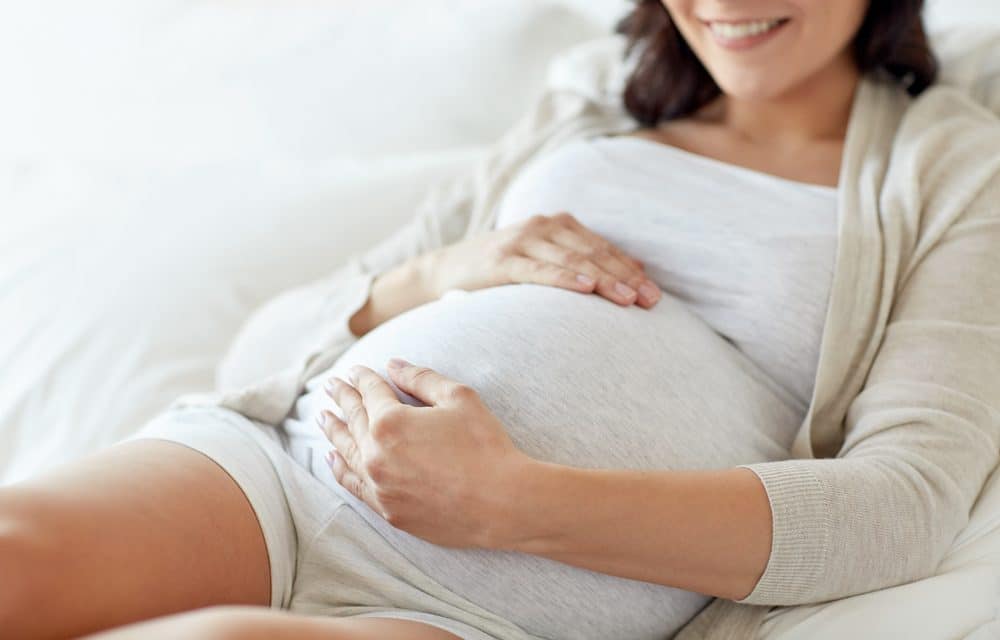When you lose your waist … and other information that interests you!
Pregnancy is a natural process and our body is perfectly prepared to assume it. In addition, each pregnancy and each woman are different, so do not believe that everything that is told or seen on Instagram will happen to you.
If you are curious to know when you start to lose your waist, how many sizes your bra can increase, or when it is advisable to start wearing maternity clothes, here are some clues!
The first 4-6 weeks
Why don’t you notice anything? You may feel a little tightness or more tenderness in your breasts, tiredness, swelling in the lower abdomen or mood swings, but these symptoms are similar to those of premenstrual syndrome, so they are often confused.
The moment the embryo is implanted, the muscle fibres of the uterus thicken, the placenta and amniotic fluid begin to form, the volume of blood in your body increases, and the breasts are prepared to increase their fat deposits and start developing milk ducts.
You will barely gain weight. It is normal to gain one or two kilos (due to the increase in blood volume and the development of the amniotic cavity and the placenta, etc.). In fact, the baby only weighs 50 grams! But it is also common to have nausea and vomiting, so you can even lose weight.
More sleepiness and lack of energy. You may also have more drowsiness and lack of energy because blood pressure is lower.
From 12 weeks
Say goodbye to your waist! You will begin to notice that your abdomen widens and rounds slightly, as well as the thighs. Put on anti-stretch cream, since rapid changes in body weight or volume can favour their appearance.
Your breast grows. You will notice that its volume increases, it is more sensitive and somewhat heavier. You can start looking at bras of larger sizes and with slightly wider straps to improve the support.
Your uterus grows. The growth of the uterus compresses the bladder, so it is normal for you to want to urinate more frequently. And, sometimes, it can compress the nerves of the legs, so you can also have cramps.
Pigmentation changes. It is possible that the breast areola becomes a little darker and that from the centre of the abdomen to the pubis appears a vertical dark line (the linea alba). It is due to hormonal changes and disappears in a few months after delivery. There may also appear spots on the face, so try not to expose yourself much to the sun and always use sunscreen.
Your heart pumps faster. It has twice the work and pumps about 6 litres per minute to favour the development of the baby.
Digestive problems. The hormones relax the muscles to favour abdominal distension, which can favour the appearance of small digestive discomfort, constipation and burning or reflux.
From 20 weeks
In the fifth month of pregnancy, fluid retention may appear. If you are standing for a long time, and / or it is hot, you may have swollen ankles at the end of the day. Try to put your feet up, wear comfortable shoes and perform manual lymphatic drainage massages to relieve.
The uterus gains ground: it already shows below the navel and grows at a rate of approximately 1 cm each day. The increase in the size of the uterus can compress some veins and hinder venous return, and hormonal changes favour the appearance of varicose veins.
You will gain a few kilos. In the second trimester it is when you will gain more weight and it is completely normal. The pace is about half a kilo per week, approximately (usually 5-7 kg in total). The important thing is that the baby develops well, so either if you gain a little more or if you do not reach 7 kg, do not worry. It is often believed that pregnant women gain more weight in the last trimester, but in the last three months most of the weight gained corresponds to the growth of the baby and the increase in amniotic fluid. In addition, in the last three months it is better not to gain more weight than recommended, as it increases the risk of developing gestational diabetes and caesarean section.
Breasts continue to grow. They can triple their original size! And the areolas are getting bigger. Use wide-strap, 100% cotton and breathable bras.
It also increases the heart rate to favour the supply of food to the baby and its development.
Take care of your gums. The gums may be somewhat weaker and may swell or bleed easily (also by the action of hormones). Use soft brushes and toothpastes indicated for sensitive gums.
Dizziness: You can get dizzy as you have lower tension, especially if you get up quickly after lying down or sitting for a while.
Between 30 and 35 weeks
Displacement of the centre of gravity. As the uterus gains space, and your belly increases in volume, the centre of gravity of your body moves, because now it must support a greater weight of your front. In addition, the joints of the pelvis are also loosened, which can cause back pain. To avoid this, try to sit with your back straight, do not wear high heels and bend down by bending your knees. Do not take too much weight and exercise regularly (walking in comfortable shoes and swimming are very useful).
Sleeping problems. The increase in the volume of the abdomen will make it difficult for you to find a suitable position for sleeping. Lie on your side, with one knee raised towards the chest and the other extended, and put a pillow between the two legs, to compensate.
The uterus is very high. The uterus can reach up to 14 centimetres above the navel and this causes the intestinal organs to move upwards and you may notice pain or pressure in the chest area. To relieve it, you can apply local heat or take paracetamol.
Efforts and shortness of breath: the displacement of the intestinal organs towards the diaphragm, can make you feel lack of air. Try to sleep on your side (on the left side) by placing your head somewhat higher (use a couple of pillows).
36 – 40 weeks
The baby descends: it is likely that you will notice your belly a bit lower due to the positioning of the foetus in the pelvis, but the rib pains and gastroesophageal reflux after meals also begin to decrease.
Increased vaginal discharge: it is normal, and you should not confuse it with the water breaking. The amniotic fluid is clear and watery, and the normal vaginal discharge is more whiteish mucous.
False labour contractions: you will notice that your belly gets hard irregularly, especially when you walk or climb stairs. These are Braxton Hicks contractions. You should not confuse them with labour contractions because they are not regular, painful, or increase in intensity.
Have I gained a lot or a little? In total, and at the end of pregnancy, it is normal to have gained between 9 and 14 kilos.
Tiredness and oedema. You will feel very tired, and your ankles and wrists may swell due to the difficulty of venous return and compression of the median nerve.
One final tip: after delivery, weight loss is progressive, so don’t hurry. Also, if you breastfeed, your child is likely to be hungrier, and it is not convenient for you to diet until you recover. So, give yourself time, rest as much as you can, ask for all the help you need and, above all, enjoy your new motherhood!














